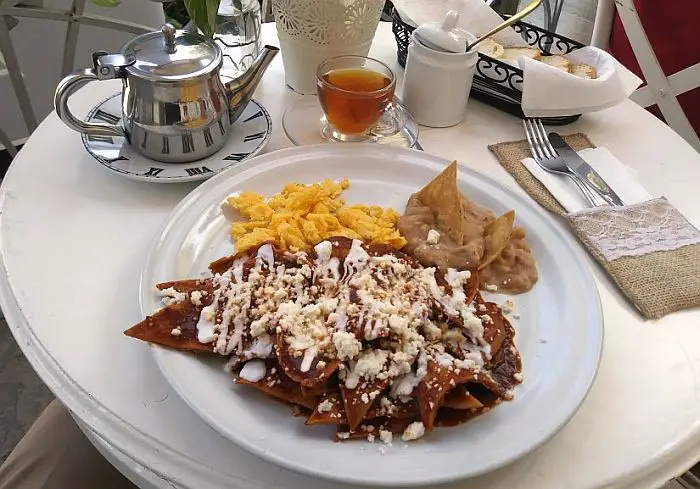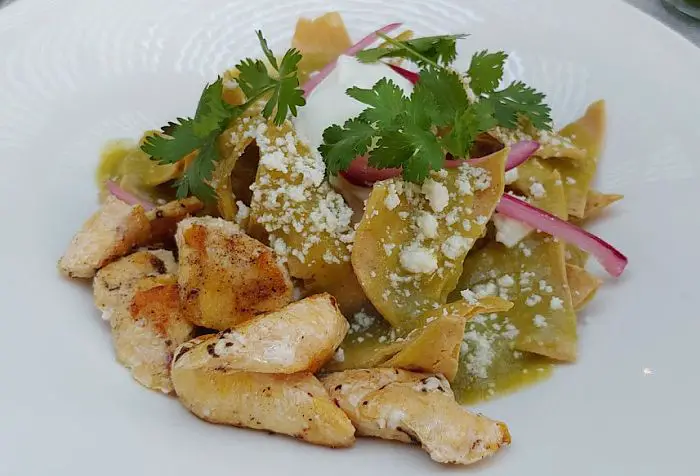I’ve lived in a Spanish colonial city called Guanajuato south of the border on and off for the past decade and travel around a fair bit domestically in normal times. One of the big advantages of that is that I get to eat the breakfast foods in Mexico on a regular basis. When I go out for a Mexican breakfast, I’m always a happy diner.

In many countries, it’s tough for a traveler from the U.S., Canada, or Europe to get jazzed up about the typical local breakfast dishes. That fish ball soup or innards with rice may appeal to the locals, but our stomachs didn’t grow up with that first thing in the morning and many of us will take a pass.
Mexico presents familiar ingredients, but just takes everything up a notch in terms of flavors. It’s not unusual to see 15 or even 30 different egg concoctions on a restaurant menu for desayuno. Many of them just incorporate minor changes of course: a different salsa here, a side of beans there, or slices of avocado. Red salsa instead of green, or different peppers in your omelet.
A Typical Mexican Breakfast in Restaurants
One of the most common breakfast dishes of Mexico is huevos rancheros, which is sunny side up eggs on a flour tortilla, mild red salsa, and a sprinkling of cheese or a drizzle of cream. At the top of this post is a modification called huevos divorciados—divorced eggs. One side has green salsa, one side red. This is my go-to order most of the time and when it comes with a side of chilaquiles (more on that in a minute), I’m doubly satisfied. If the corn tortillas are patted by hand and the salsa is made in house, even better.
 I have a fair number of photos of Mexican breakfasts going back to the dawn of digital cameras, but they’re not all that photogenic. Most of the time you’ll get something that tastes fantastic, but doesn’t look all that pretty. Take huevos rancheros: there are lots of browns, blacks, and reds in the mix, with the fried eggs covered up by the salsa. There are few bright colors unless you’re at a fancy hotel with a real chef who likes to garnish and present something pretty. As with this amazing spread to the right I got at a resort in Los Cabos.
I have a fair number of photos of Mexican breakfasts going back to the dawn of digital cameras, but they’re not all that photogenic. Most of the time you’ll get something that tastes fantastic, but doesn’t look all that pretty. Take huevos rancheros: there are lots of browns, blacks, and reds in the mix, with the fried eggs covered up by the salsa. There are few bright colors unless you’re at a fancy hotel with a real chef who likes to garnish and present something pretty. As with this amazing spread to the right I got at a resort in Los Cabos.
Usually when you order Mexican food for breakfast you’re going to get some combination of beans, tortillas or chips, eggs, and salsa. Vegetables don’t play a big part in the mix except for avocados and peppers, though if you order an omelet you can have them throw in whatever you want, of course. If you’re at some resort buffet, there will be a wide array of fruit, but at typical Mexican restaurants you need to order a fruit plate–which will usually be full of what’s local and fresh–or you order a juice.
I always like to get fresh-squeezed orange juice, which is cheap and abundant, or get a jugo verde (green juice) which is usually orange and sometimes pineapple juice blended with celery, cilantro, nopal (cactus), and sometimes ginger. If you’re at a juice stand, you can ask them to toss in whatever else is lying around too for additional vitamins.
One of the most common dishes you’ll see on a traditional Mexican breakfast menu is chilaquiles, which are basically breakfast nachos. The plate or bowl will have fried corn tortilla chips, refried beans, cream and/or white cheese, and a protein. You normally have two choices that you can expect the waiter to ask you. The first is “Red or green?” That is your salsa preference. The other question is “Chicken or eggs?” You occasionally see another choice, but it’s usually one of those. If you choose eggs, they’ll sometimes ask if you want them scrambled or another way, but scrambled is the default.

Sometimes the eggs are on top of the chips and refried beans, making it really look like a plate of breakfast nachos. Other times the items will be separated, leaving it up to you whether to combine them or not.
There are often some thinly sliced red onions on top, sometimes a bit of parsley to add some color. The chicken in chilaquiles is usually shredded, but not always. Here’s how it arrived at a restaurant where I ordered the dish in San Miguel de Allende:

Another authentic Mexican breakfast item you’ll see on nearly every menus is Mexican eggs (huevos a la Mexicana), which are basically just eggs scrambled with onions, green chile peppers, and salsa. Molletes show up everywhere though I’ll admit I hardly ever order these as they seem too boring compared to everything else. They’re made from a bread roll sliced in half and toasted and then spread with refried black beans and cheese for the basic version, with ham and/or eggs for something heartier. This is a good go-to if you can’t stomach spicy food and want something filling that’s bland.
Mexicans eat enchiladas at any time of day, so you’ll often see them on a breakfast menu as well. The typical ones are filled with chicken and covered with salsa and sprinkled cheese, though you’ll usually see a few different varieties on offer. Some of the breakfast foods in Mexico are the same things you’d eat at lunch and often the two meals run close together. If you’re in the Baja Peninsula, for example, you’ll see people eating fish tacos for their first meal of the day, but they’ll be eating this “breakfast” at 11:30 in the morning. Lunch won’t be until the middle of the afternoon.
Then when you’re in different regions of Mexico, there will be local specialties that you’ve probably never seen before. The picture below is huevos Guerrero—scrambled eggs with dried beef strips and salsa, with a side of feta-like white cheese. (It’s named after a state in Mexico.)

If you’re in the Yucatan state, you might see items with pumpkin seeds or their famous marinated slow-cooked pork, cochinita pibil. More common though is huevos motuleños. This dish features fried tortillas topped with black beans, eggs, mild tomato sauce, peas, ham, and cheese.
At a simple restaurant where locals are eating, you’ll usually pay around $2 to $5 for a hearty breakfast of one of the popular Mexican breakfasts, usually including bread and coffee. Even at a fancy hotel where you’re paying for atmosphere and waiters in formal garb, it’s rare to pay more than $10. And often those eggs are straight off a local farm, orange yolks and all. Yum.
Street Food Breakfasts in Mexico
While I love a good sit-down breakfast in Mexico, on a typical work week I’ll often grab something to eat quickly or bring home. That’s a much more typical option among working Mexicans as well, who are more apt to take a long afternoon lunch than a long breakfast when they’re not on vacation.
So the street food stands in Mexico are busy in the mornings if their specialty is something you would eat for breakfast. The not-photogenic but delicious option to carry is tamales, which come in a variety of flavors, even sweet versions. The common ingredient is a soft steamed corn flour pillow wrapped in corn husks or banana leaves and the differentiator is what it’s stuffed with. The most common options are chicken with green sauce or pork with red sauce, but there’s a vegetarian version where I live called aselga that has cheese, veggies, and lots of swiss chard greens. Funny enough, it’s the spiciest one! Tamales are a screaming bargain if you’re traveling on a budget: normally US75 cents each or less and with two you’ll be stuffed.
In central Mexico you’ll also see a lot of gordita stands. Gorditas (little fat ones) are puffy corn tortillas grilled on a hot surface, split in the middle, and stuffed with whatever you pick from a menu. You can get eggs, shredded beef, chicken with mole, potatoes, or as many as a dozen other options from even the most humble stand. This is a good option for vegetarians (though get it without the refried beans or there will be a little lard). The same stands will often be selling tlacoyos, which are a greasy deliciousness of friend oblong corn cakes stuffed with white cheese and salsa.

Mexican food street items like gorditas and tlacoyos are generally 75 cents to $1.25, so you can order a few and they won’t set you back much. Get a fresh-blended fruit juice nearby if you’re in a market area and that’ll be around the same price.
Mexican bakeries are another quick-stop option in any town, though you want to visit one where you know they are baking pan dulce in the morning rather than the afternoon. Otherwise, no matter what you get, it’s going to look better than it actually tastes. What you get won’t cost much though: a concha or doughnut will be 30 cents or so.
If you ever come to my city of Guanajuato, you can sample plenty of these goodies on a Guanajuato food tour of the street stalls. It’s a company I founded, with tours run by local bilingual guides, where you walk and eat for four hours around the historic center of this UNESCO World Heritage city. Follow that link for more info.
What About Coffee in Mexico?
Only a few places in Mexico have much of a coffee culture history, but everywhere is catching up. Mexican coffee is actually quite good if you can find a cafe that is serving local beans: Veracruz and Chiapas are both well-known around the world as regions that produce high-quality coffee beans.
The best bets are locally-owned coffee bars run by someone who knows what they’re doing, someone who sources their beans carefully and knows what to do with them. Otherwise, you have two chain options: Starbucks or The Italian Coffee Company. Both have hundreds of outlets across the country now.
If you see “Mexican coffee” or “cafe de olla,” that’s a different taste sensation. It’s coffee that is made in a big clay pot (the “olla) and has raw sugar, cinnamon, and sometimes other spices like clove and anise mixed in. I don’t drink it that often, but it’s a nice change of pace. You’ll usually see it on the buffet table at all-inclusive resorts if it’s a place with some Mexican guests.
None of these Mexican breakfast items are going to set you back very much unless you’re at a 5-star hotel. These days, Mexico is one of the cheapest places to live in the world thanks to a peso value that has been dropping for years against the dollar. Figure on five bucks or less at a regular restaurant for a nice breakfast, less than a dollar for a tamale or gordita on the street.
How about you? What are your favorite breakfast foods in Mexico?

Love this article. This should keep me in breakfasts for awhile. A lot to try. Huevos rancheros are already one of my favourite breakfasts. I’m sure to love these others. Thanks.